Kodak Auto-Focus Camera User Manual
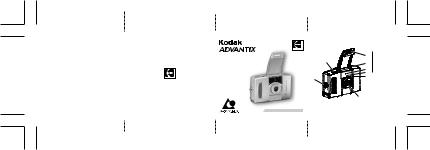
|
|
|
Camera Identification |
|
|
|
|
T570 Auto-Focus |
|
1 |
Shutter button |
|
|
2 |
3 |
Print-format switch |
|
|
|
Camera |
2 |
Lens cover/flash |
|
|
|
3 |
5 |
Viewfinder |
|
|
|
|
1 |
4 |
Self-timer lamp |
|
|
|
4 |
6 |
Meter-cell window |
|
|
|
7 |
Lens |
|
|
|
|
5 |
8 |
Strap post |
|
|
|
6 |
|
|
|
|
|
8 |
|
|
|
Consumer Imaging |
|
|
|
|
|
EASTMAN KODAK COMPANY |
|
|
|
|
|
Rochester, NY 14650 |
|
|
|
|
|
|
|
7 |
|
|
|
© Eastman Kodak Company, 2002 |
|
|
|
|
Unfold the front and back flaps of this manual for easy reference to the camera’s parts. |
Pt. No. 20228531 |
ENGLISH/FRANÇAIS |
Unfold the front and back flaps of this manual for easy reference to the camera’s parts. |
||
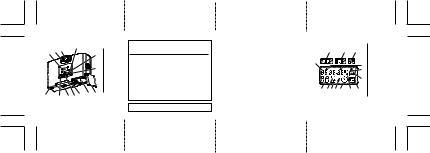
Camera Identification
12
|
11 |
|
|
|
10 |
|
|
|
9 |
|
|
21 |
20 |
19 |
18 |
|
|
|
9 |
LCD panel |
|
|
|
10 |
Flash/camera- |
|
|
13 |
|
ready lamp |
|
|
|
11 |
Viewfinder |
|
|
|
|
eyepiece |
|
|
|
12 |
Film-rewind |
|
|
|
|
button |
|
|
14 |
13 |
MENU |
|
|
14 |
ENTER |
|
|
|
|
15 |
Film door |
|
|
|
16 |
Film chamber |
|
|
|
17 |
Film-door |
|
|
|
|
switch |
|
|
|
18 |
SELECT |
|
|
|
19 |
Battery door |
|
|
|
20 |
MODES |
|
|
|
21 |
Tripod socket |
17 |
16 |
15 |
|
|
This device complies with part 15 of the FCC Rules. Operation is subject to the following two conditions: (1) this device may not cause harmful interference, and (2) this device must accept any interference received, including interference that may cause undesired operation.
NOTE: Your model camera has been tested and found to comply with the limits for a Class B digital device, pursuant to Part 15 of the FCC Rules. These limits provide reasonable protection against interference in residential use. The camera generates, uses and can radiate radio frequency energy and, if not used in accordance with the instructions, may cause interference to radio communications. There is no guarantee that interference will not occur. If this camera does cause interference to radio or television reception, which can be determined by turning the camera off and on, you may reduce the interference by the following:
— Reorient or relocate the receiving antenna.
— Increase the separation between the camera and the receiver.
— Consult the dealer or an experienced radio/television technician for help.
Changes or modifications not approved by the party responsible for compliance could void the user’s authority to operate the equipment.
This Class B digital apparatus meets all requirements of the Canadian Interference-Causing Equipment Regulations
LCD Panel
|
|
23 |
|
24 |
|
25 |
22 |
|
|
|
|
|
26 |
|
|
|
|
|
|
|
|
|
|
|
|
|
27 |
|
|
|
|
|
|
28 |
35 |
34 |
33 |
32 |
31 |
30 |
29 |
22Date/time display
23Auto-flash indicator
24Fill-flash indicator
25Flash-off indicator
26Mode-selector arrow
27ISO film-speed display
28Infinity-focus indicator
29Nightview indicator
30PM indicator
31Self-timer indicator
32Title-select indicator
33Film-presence symbol
34Battery symbol
35Picture counter

KODAK ADVANTIX
T570 Auto-Focus Camera
NEED HELP WITH YOUR CAMERA OR MORE INFORMATION ABOUT THE ADVANCED PHOTO SYSTEM?
Go to our web site at http://www.kodak.com or call:
Kodak (Canada only) from 8:00 a.m. to 5:00 p.m. (Eastern time) Monday through Friday at 1 (800) 465-6325, ext. 36100; for the Toronto area, call (416) 766-8233, ext. 36100.
Kodak (USA only) from 9:00 a.m. to 7:00 p.m. (Eastern time) Monday through Friday at 1 (800) 242-2424.
When you call, please have your camera available.
For warranty purposes, please keep your sales receipt as proof of the date of purchase.
ENGLISH
1

CONTENTS |
|
CAMERA FEATURES AND BENEFITS |
.... 3 |
GETTING STARTED ................................. |
5 |
Loading the battery .............................. |
5 |
Date and time ........................................ |
5 |
Setting the date ................................ |
5 |
Setting the time ................................ |
6 |
Attaching the camera strap .................. |
7 |
CONTROL-BUTTON ACTUATOR ............. |
8 |
OTHER BATTERY INFORMATION ........... |
8 |
Low-battery indicator ............................ |
8 |
Battery tips ............................................ |
8 |
Power shut-off ....................................... |
9 |
LOADING THE FILM .............................. |
10 |
TAKING PICTURES ............................... |
11 |
Typical print sizes (formats) ................ |
12 |
Using the focus lock ........................... |
13 |
Tips for better pictures ....................... |
14 |
FLASH AND PICTURE- |
|
TAKING OPTIONS ............................. |
14 |
Flash/camera-ready |
|
lamp indicator ................................. |
15 |
Auto flash ........................................... |
15 |
Fill flash ............................................... |
15 |
Flash off ............................................. |
15 |
Nightview ............................................ |
15 |
Infinity focus ....................................... |
16 |
Selecting the flash and |
|
picture-taking options .................... |
16 |
Flash/warning-lamp signals ............... |
16 |
Flash-to-subject distance ................... |
17 |
USING THE SELF-TIMER ...................... |
17 |
SETTING THE PRINT TITLE |
|
AND LANGUAGE ............................... |
18 |
Title-select list ..................................... |
19 |
Language-select list ........................... |
19 |
UNLOADING THE FILM ......................... |
19 |
Automatic rewind ................................ |
19 |
Manual rewind .................................... |
20 |
CARING FOR YOUR CAMERA .............. |
20 |
TROUBLESHOOTING ............................ |
21 |
SPECIFICATIONS .................................. |
23 |
2

CAMERA FEATURES AND BENEFITS
Three Print Formats
•You can take three different size pictures: Classic (C), Group/HDTV (H), and Panoramic (P) pictures from the same film cassette. The viewfinder changes to show the selected picture size.
Picture Quality Information Exchange (PQix)
•This camera records vital scene data on the film’s magnetic information strip and communicates that information to the photo lab to optimize lighting and color for betterlooking prints.
Date, Time, and Title Imprinting
•The date, time, and cassette ID number are printed on the back of your prints, which makes it easy to organize pictures and order reprints. You can choose from one of 10 preprogrammed titles (6 languages available) to print on the back of the prints. See your photofinisher for a full description of the available services.
Flip Flash
•The extension of the flash helps to minimize red eyes in flash pictures and prevents hand obstruction in front of the flash. When the flash is closed, it protects the lens and viewfinder.
Double Exposure Protection (DEP)
•You don’t need to worry about accidentally re-exposing your film. Your camera reads the Film Status Indicator (FSI) on the film cassette to prevent re-exposure.
Easy, Drop-in Loading
•Easy, drop-in loading is fast and virtually error-free, eliminating blank rolls and double exposures. The camera uses KODAK ADVANTIX Film. The film cassette, unlike the traditional 35 mm cartridge, becomes the carrier and storage container for the processed film.
3

Film Status Indicator (FSI)
•A highlighted indicator advances from one symbol to another to identify the status of the film inside the cassette.
1 |
2 |
|
4 3
Processed Negatives
Unexposed
Partially exposed
Fully exposed
Look for this logo to be certain that the film you buy is made for this camera.
Look for this logo to select a certified photofinisher for developing your film and to assure that you get all the features of the Advanced Photo System.
4
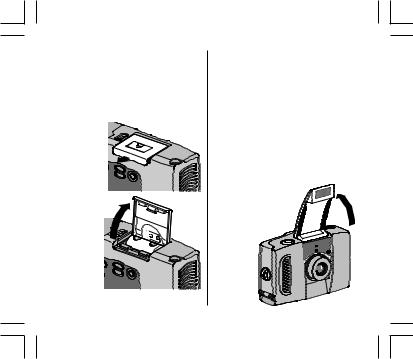
GETTING STARTED
Loading the battery
This camera uses one 3 V lithium KODAK KCR2 (or equivalent) Battery that supplies power for all camera operations.
1. Open the battery door (19).
•Before you remove the old battery,
close the lens cover/ flash.
2. Insert the battery into the chamber as shown.
3.Snap the battery door
closed.
• After you load a
new
battery into the
camera,
you will need to reset the date and time.
Date and time
This camera has a quartz clock and automatic calendar through the year 2040. It uses the film’s magnetic data-recording capability to record date and time information which your photofinisher imprints on the back of your prints.
Setting the date
You can choose from three formats: month/day/year, day/month/year, or year/month/day.
1.Completely lift up the Lens cover/ flash (2) to raise the flash and to turn on the camera.
5
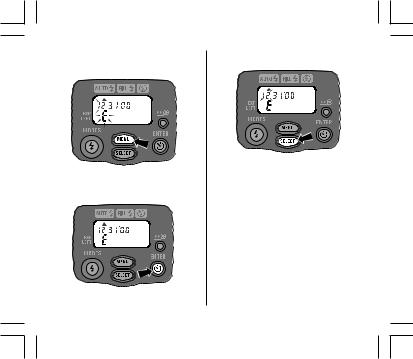
2.Repeatedly press MENU (13) until the blinking “date format” of your choice appears on the LCD panel (9).
•The blinking “E” indicates there is no film in the camera.
3.Press ENTER (14) to set the format.
•If the camera is already at this format, you can bypass this step.
4.Press SELECT (18) to actuate the setting for month.
5.Repeatedly press and/or hold SELECT to select the new number for month.
6.Press ENTER (14) to set the month and to actuate the setting for day.
•Press ENTER again if you want to end the selection.
7.Follow steps 4 and 5 to finish setting the date.
Setting the time (hour/minutes)
The camera has a 12-hour clock with PM display.
1.Completely lift up the Lens cover/
flash (2) to raise the flash and to turn on the camera.
6
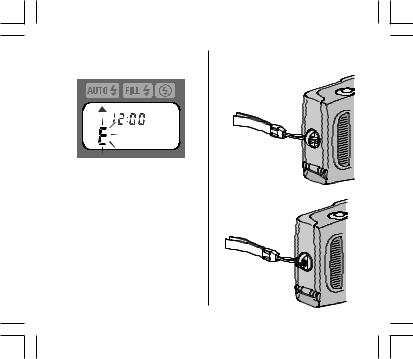
2.Repeatedly press MENU (13) until the time appears on the LCD panel (9).
3.Press SELECT (18) to actuate the setting for hour.
4.Repeatedly press and/or hold SELECT to select the new number for hour.
5.Press ENTER (14) to set the hour and to actuate the setting for minutes.
6.Follow steps 3 and 4 to finish setting the time.
•The camera automatically defaults to the date setting but you can view the time by pressing MENU.
Attaching the camera strap
1.Insert the shorter looped end of the strap behind the Strap post (8).
2.Thread the longer end of the strap through the shorter loop.
3. Pull the strap tight.
7
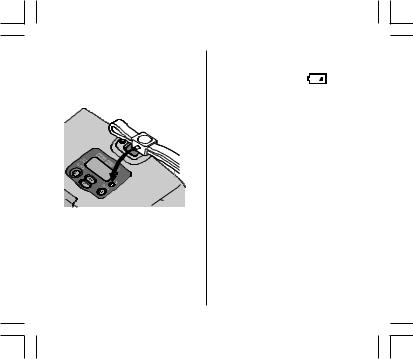
CONTROL-BUTTON ACTUATOR
You can use the knob on the clasp of the camera strap to actuate the small control buttons on the camera.
OTHER BATTERY
INFORMATION
Low-battery indicator
It’s time to replace the battery when —
•the Battery symbol (34) “blinks” on the LCD panel (9) or
•none of the indicators, except for a steady battery symbol, appears on the LCD panel and the Shutter button (1) cannot be operated.
Battery tips
•Dispose of battery according to local and national regulations.
•Keep a spare battery with you at all times.
•Read and follow all warnings and instructions supplied by the battery manufacturer.
•Keep batteries away from children.
•Do not try to take apart, recharge or short circuit the battery, or subject it to high temperature or fire.
8
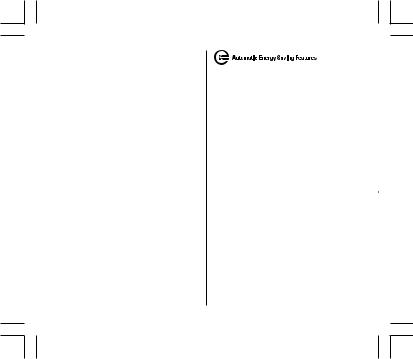
•Store the battery in its original packaging prior to use.
•Do not use rechargeable batteries.
•Remove the battery from the camera when the camera is not going to be used for an extended length of time.
•In the unlikely event that battery
fluid leaks onto your skin, contact your local health care provider. In the U.S., contact Kodak Health, Safety and Environment Information at 1-716-722-5151.
•In the unlikely event that battery fluid leaks inside the camera, contact your local Kodak Customer Service representative. In the U.S., customers can contact the Kodak Information Center (KIC) at 1-800-242-2424.
Power shut-off
To conserve battery power, the camera automatically goes to sleep if
it is not operated for more than
2 ½ minutes. You can press any of the control buttons, except for the print-format switch, or close and reopen the Lens cover/flash (2) to awaken the camera. When the camera is not used for an extended time, close the lens cover/flash to completely turn off the camera.
9
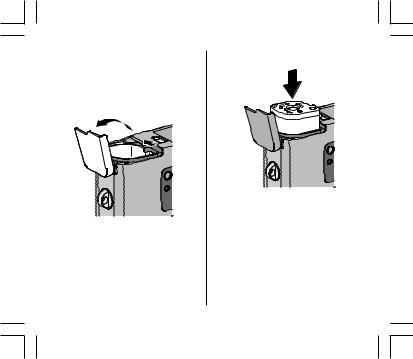
LOADING THE FILM
You can load film into the camera with the camera on or off.
1.Turn the camera upside down and move the Film-door switch (17) to open the Film door (15).
•The safety interlocked film door opens only when the film chamber is empty or the film in the camera is completely rewound into the film cassette.
2.Insert the film cassette completely into the Film chamber (16).
3 4
2 1
•Make sure the Film Status
Indicator (FSI) on the film cassette is at ●(#1 position) for a new cassette.
•Do not force the film cassette into the film chamber.
3.Close the film door to start the automatic film advance.
•The Picture counter (35) on the
LCD panel (9) shows the number of pictures remaining on the film.
10
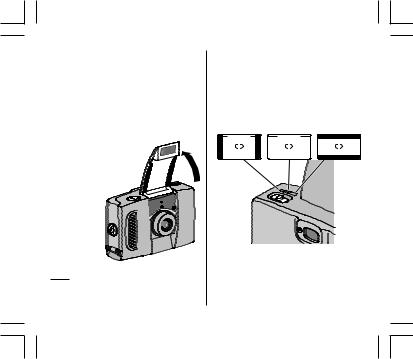
TAKING PICTURES
You can take Classic (C), Group/
HDTV (H)*, and Panoramic (P) pictures on the same film cassette. Your photoprocessing cost may be based on the format size(s) that you use to expose
the film.
1.Completely lift up the Lens cover/
flash (2) to raise the flash and to turn on the camera.
• The ISO film speed briefly appears on the LCD panel followed by the date.
*High Definition Television (HDTV) prints are the same aspect ratio as the TV for CD interface capabilities.
2.Frame your subject within the Viewfinder eyepiece (11). For a sharp picture, stand at least 1.3 ft (0.4 m) from your subject.
3.Slide the Print-format switch (3) to select the desired format (C, H, or P). The viewfinder changes to show the selected
picture size.
C H P
•See the Typical print sizes (formats) on page 12.
11
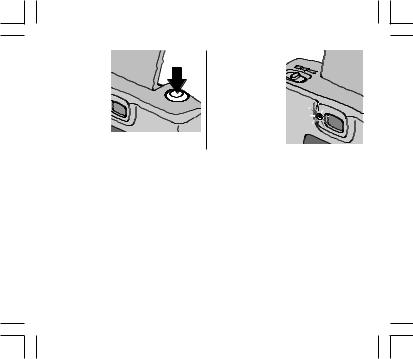
4. Partially press |
5. When the Flash/ |
down the |
camera-ready |
Shutter |
lamp (10) glows |
button (1). |
green, fully press |
|
down the shutter |
|
button to take |
|
the picture. |
|
• See the Flash/ |
|
warning-lamp |
|
signals on |
|
page 16. |
Typical print sizes (formats)
C |
H |
P |
Classic |
Group (HDTV) |
Panoramic |
3.5 x 5 in. or 4 x 6 in. |
3.5 x 6 or 4 x 7 in. |
3.5 x 8.5 in. to 4 x 11.5 in. |
(88.9 x 127 mm or |
(88.9 x 152 mm or |
(88.9 x 216 mm to |
102 x 152 mm) |
102 x 178 mm) |
102 x 292.7 mm) |
NOTE: Your photofinisher generally provides 4 x 6, 4 x 7, and 4 x 11.5 in. (102 x 152, 102 x 178, and 102 x 292.7 mm) sizes. Some local printers may offer 3.5 x 5, 3.5 x 6, and 3.5 x 8.5 in. (88.9 x 127, 88.9 x 152, and 88.9 x 216 mm) sizes.
12
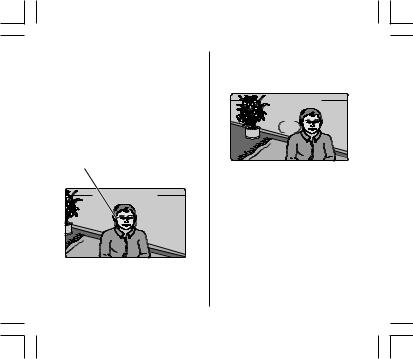
Using the focus lock
This camera automatically focuses on whatever is within the Auto Focus (AF) circle of the viewfinder eyepiece. To get a sharp picture, make sure the AF circle is on your main subject. If you want to take the picture with the subject positioned outside of the AF circle, use the focus lock
as follows:
1.Place the AF circle on the subject that you want focused in the picture.
AF Circle
VIEWFINDER
2.Partially press down and hold the Shutter button (1) to lock the focus position.
3.While still partially pressing down on the shutter button, move the camera until your subject is where you want it within the Viewfinder eyepiece (11).
VIEWFINDER
4.Press the shutter button completely down to take the picture.
13
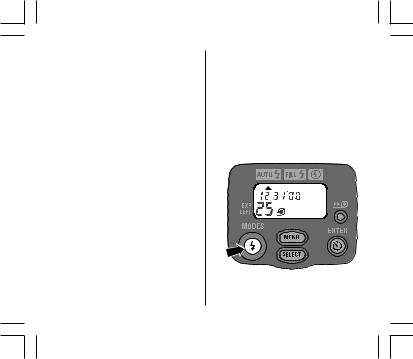
Tips for better pictures
•Move close enough to your subject so it fills the viewfinder but not closer than
1.3ft (0.4 m).
•Take pictures at the subject’s level. Kneel down to take pictures of children and pets.
•Hold your camera vertically to capture tall, narrow subjects, such as a waterfall, skyscraper, or a single person.
•Add interest to your picture by framing it with a tree branch, a window, or
even the rails of a fence.
•Keep the sun behind you. This provides the best subject illumination.
•Stand at an angle to shiny surfaces like windows or mirrors to avoid flash reflection and bright spots in
your pictures.
•Turn on all room lights and have your subject look at the flash to reduce red eyes in flash pictures.
FLASH AND PICTURE-
TAKING OPTIONS
Besides the auto-flash mode (default setting of the camera), you can select fill flash, flash off, infinity focus without flash, and nightview with flash.
Repeatedly press MODES (20) to select the flash mode that best suits your subject and surroundings or a picture-taking mode that lets you tailor the camera’s fully
automatic settings.
14
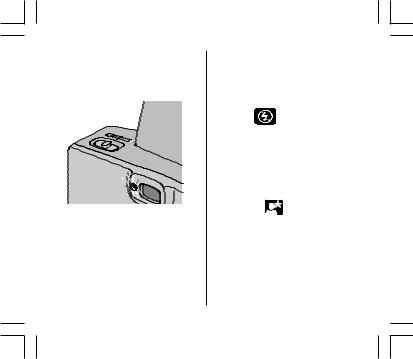
Flash/camera-ready lamp indicator
When you partially press down the Shutter button (1) and the Flash/camera-ready lamp (10) glows green, the flash is fully charged and ready for you to take pictures.
Auto flash 
In dim light, such as indoors or outdoors in heavy shade, or on dark overcast days, you need flash. Your camera features an automatic flash that fires when you need it. The flip-up flash helps to minimize red eyes in flash pictures and prevents hand obstruction in front of the flash.
Fill flash 
When in bright sun or when bright light comes from behind the subject, dark shadows (especially on faces) may occur. Use fill flash to lighten these shadows and to add sparkle to your subject’s eyes.
Flash off
When you do not want to use the flash, especially indoors where flash is prohibited, or to capture the ambiance of existing light, use the flash-off feature. Use a tripod or place the camera on another firm support, and use high-speed film because the shutter speed in these situations will most likely be slow.
Nightview
In this mode, the camera balances the flash and existing light exposure so you can take beautiful pictures of people at sunset or at night. Use a tripod or place the camera on another firm support, and use high-speed film because the shutter speed at night will most likely be slow.
15
